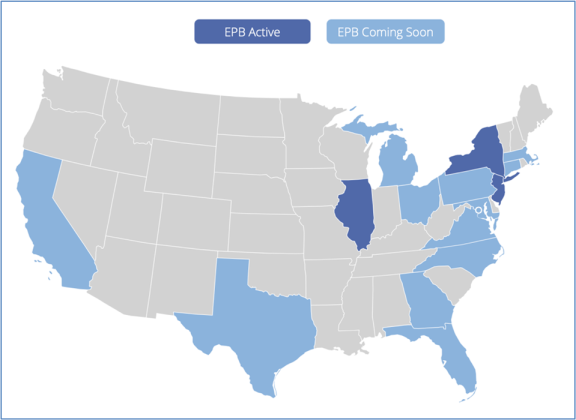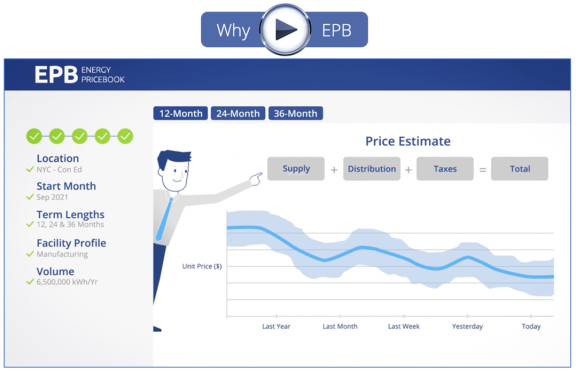
Interview with Mark Nuzzo and Tom Kowenhoven - January 2021
ERCG continues its ABC leadership interview series with Mark Nuzzo and Tom Kowenhoven, Principals and Co-Founders of Energy PriceBook. Energy PriceBook is a revolutionary price estimation tool for the C&I energy market, and they launched in early 2021. We sat down with Mark and Tom and discussed several topics, including –
- Major lesson learned from the auto industry: don’t rely on supplier-provided pricing because that leads to two potential problems, a “race to the bottom” or gaming
- Showing one or two pricing components is easy but can actually prolong the decision-making process; that’s why it’s important to deliver an all-inclusive custom price
- Why they don’t ask for a customer’s meter data
ERCG: Before we get into Energy PriceBook (EPB), let’s talk a
little about your background and how an energy brokerage business led you down the path to start this new business model?
Mark Nuzzo and Tom Kowenhoven: Energy PriceBook is the culmination of our serving the C&I retail energy market for over 20 years. When deregulation was new and evolving (2000 – 2008), we were fortunate to lead a team that successfully founded, grew, and sold a broker business that transacted 100s of millions of dollars in electricity and natural gas across Fortune 100 companies and government buying consortiums. After selling this brokerage firm, we were retained as consultants from 2009 to 2020 by large organizations with national facility/energy footprints (e.g., data centers and manufacturers). Specifically, we provided their facility and finance teams with customized energy management software, data management services, energy price forecasts, and legal/contract support.
With Energy PriceBook, we complete the transition from our early days of brokering electricity and natural gas and now operate as a neutral, third party provider of high-value software to all energy market participants – buyers, suppliers, brokers, consultants, associations, and grid/government organizations. Our mission is to always listen and be ever-ready to serve our customers by delivering game-changing solutions and immediately actionable intel that enables not only transparency, but more importantly insightful collaboration within the energy markets.
ERCG: You are going from a reliable business model to something completely different and new – what gives the confidence that this idea will work?
MN and TK: In the C&I space, everyone repeatedly asks “What’s a good price for energy?” After working with buyers and suppliers for the past 20 years to answer this ever-evading question, we decided to launch Energy PriceBook, which addresses a fundamental market need in a way that no current solution does.
From a single price request and without requiring meter data, Energy PriceBook immediately calculates current day and historical price estimates, customized for any size business and broken out by supply, distribution/delivery and taxes. In addition, we receive absolutely no price feeds from suppliers (neither matrix nor custom pricing), but rather EPB utilizes its own patent-pending, pricing engine that is completely independent of retail suppliers, brokers, and utilities.
This autonomous pricing capability, coupled with its speed and accuracy, has positioned Energy PriceBook to be a neutral and reliable, third party, price benchmark for retail energy. C&I market participants want a pricing solution that: (1) provides actionable intel, (2) reduces time/work and (3) saves money, and our users have stated that Energy PriceBook delivers on all three.
ERCG: Energy PriceBook sounds a bit like Kelley Blue Book or the car pricing services out there. In what ways is your service inspired by those and how are their products a useful model for energy?
MN and TK: In addition to the retail energy space, we looked at a variety of pricing services in the automotive industry (e.g., Kelley Blue Book, TrueCar.com, Cars.com, Edmunds), real estate industry (e.g., Zillow), finance industry (e.g., Lending Tree), and insurance industry (e.g., Esurance). The key takeaways from our research was that an online pricing service has to be applicable to all users, fast, accurate, and easy to use.
We also learned what not to do. Most online pricing services, including the current energy pricing websites, are 100% dependent upon pricing feeds from the supplier community, which can become problematic. For example, when third party information contains supplier raw costs, buyers leverage this data to engage in a race to the bottom, causing suppliers to stop providing information to benchmarking services. Conversely, when suppliers game third party pricing information by providing inflated rates and then contract at lower prices, buyers quickly realize that the savings are fabricated and stop using the third-party source. (Reference TrueCar.com history.)
Our Conclusion: Design EPB’s price estimates to operate independent of suppliers and structure these estimates in a way to foster insightful collaboration rather than positioning one party to exploit another. To this end, we designed Energy PriceBook’s current day and historical pricing as high, low and best price estimates - not a single price point. In addition, we offer detailed price breakdowns (energy, capacity, RPS, etc.) so both buyer and supplier can gain neutral, third party insights regarding more uncertain price components like capacity and transmission. We have found that empowering market participants with this type of actionable intel results in efficiency, closed deals and a competitive advantage – especially for first movers and early adopters.
ERCG: There are certainly plenty of energy pricing services out there – some paid, some free. What makes yours unique?
MN and TK: Today’s price identification processes for C&I loads are often time-consuming and inefficient, and based on our user feedback, Energy PriceBook is unlike any current solution or existing pricing method. See chart below.
|
|
Pricing Hub Services & Market Overviews |
Energy Price Websites (Matrix Pricing) |
Supplier Custom Pricing |
Energy PriceBook |
|
Quick |
X |
X |
|
X |
|
Easy |
X |
X |
|
X |
|
Does Not Require Meter Data |
X |
X |
|
X |
|
Accurate |
|
|
X |
X |
|
Custom Price Any Size Load (Large & Small) |
|
|
X |
X |
|
Total Cost – Supply, Distribution, & Taxes |
|
|
|
X |
|
Price Range |
|
|
|
X |
|
Detailed Price Breakdowns |
|
|
|
X |
|
Calculate Current Day & Historical Pricing (From Single Price Request) |
|
|
|
X |
|
Independent of Suppliers, Brokers & Utilities |
|
|
|
X |
|
Automated Price Refreshes w Historical Graph Pushes |
|
|
|
X |
|
Price Regulated & |
|
|
|
X |
Energy Pricing Hub Services & Market Overview Publications
While these information sources provide good market overviews and pricing for one or two components (e.g., hub energy prices), they lack immediate actionable intel and are not capable of delivering an all-inclusive, custom price specific to a particular facility. This requires users to compile many documents, charts and graphs and then extrapolate this data into often unclear, high level information, which can prolong, rather than streamline, the decision making process.
Energy Pricing Websites (Matrix Pricing)
These sites, along with matrix pricing published directly from suppliers, are limited to small loads (less than 1,000,000 kWhs per year). In addition, matrix pricing is plagued with load profile uncertainty, resulting in high risk, high premiums and often requires time consuming back and forth that rarely contracts at the stated list price – if it contracts at all. Furthermore, users with larger loads (greater than 1,000,000 kWhs per year) get annoyed by these websites because they are not provided with pricing, but rather asked to enter their contact information, which they rarely do. If these large load users do submit their contact info, this initiates an awkward exchange between buyer and supplier that rarely results in deal closure.
Supplier Pricing
Although the supplier pricing desk is the most accurate, custom price identification method for the supply component (not distribution and taxes), it involves meter data, which is very time consuming and cumbersome to obtain. In addition, this need for meter data often is a non-starter when suppliers and brokers are approaching prospective customers because none of these market participants have time to deal with the back and forth required to obtain it. Furthermore, refreshing and communicating supplier pricing is often a manual process, and once refreshed, users – trying to gain historical perspective to justify purchase - must then tediously send, collect, track and graph these refresh prices over time, which can take countless manhours and often results in “refresh fatigue” for buyers, suppliers, brokers and consultants.
Energy PriceBook
Based on the shortcomings of these current price identification methods, there is a need for a pricing application that can quickly and accurately profile a facility’s energy load independent of its meter data, and then calculate and immediately present to the user current day and historical price estimates for supply, distribution and taxes. Energy PriceBook does just that, in addition to providing daily refreshes of all saved price requests, detailed price breakdowns, user-initiated pricing alerts, sharing of any output chart with other stakeholders, and the ability to download all pricing data to Excel.
ERCG: Tell us a bit about your process for building your pricing information. What sort of information do you need from a user and how can they have confidence that the pricing is accurate?
MN and TK: Based on years of price verifications across 100’s of price requests, Energy PriceBook’s estimates have proven 99% accurate compared to competitive, supplier pricing. For the supply component, we are able to achieve this level of accuracy because our price engine algorithms and market inputs mirror those utilized by the pricing desks at retail energy suppliers. For distribution and taxes, EPB has modeled utility charges and applicable taxes, with data and equations being updated as rates change over time.
In addition, users can select a “Custom Profile” and enter facility specific kWh usage, KW demands and cap/trans tag values. This causes the load profile being priced by EPB to be more in line with the interval data being priced by suppliers (for the supply portion), thereby minimizing input variability and increasing the accuracy of EPB price estimates vs competitive supplier pricing. Using “Custom Profile” also results in more accurate EPB pricing for the distribution and tax components.
As a result, within seconds of entering just five (5) basic inputs – location, start month, term length(s), facility profile and volume – Energy PriceBook enables all market participants with immediate, actionable intel in the form of accurate current day and historical pricing, along with price breakdowns that back up these estimates.
ERCG: What types of companies would find value in Energy PriceBook and why?
MN and TK: Most of our users fall into one of three categories: (1) buyers, brokers/consultants and supplier sales, (2) supplier pricing desk and (3) other market participants including engineering, sustainability, equipment and energy incentive organizations, academia, associations, legal/financial and grid/government.
Buyers, brokers/consultants and supplier sales reps have stated that EPB’s value is not just limited to sourcing, but saves time/money throughout the sourcing life cycle from lead generation and site selection to post award. For example, suppliers and brokers/consultants can break into new markets, and buyers can evaluate new site locations with instant, in-depth pricing knowledge without waiting on meter data or wasting time and money collecting pricing intel. In addition, with EPB historical pricing, they can easily illustrate if market prices are at a high or low for a particular site. During the sourcing process, buyers, brokers/consultants and suppliers can compare bids vs EPB price ranges or price justify contract renewals without the time/effort of an all-out bid. Post award, they can deploy Energy PriceBook to run "what-if" scenarios (e.g., did supply price go up/down since awarding, what if we waited to source, what if we locked in earlier, what if we locked in longer/shorter terms, etc.). With EPB's distribution/delivery price and tax estimates, buyers and consultants can also easily create total cost budgets of these varying charges, which are needed even if supply is fixed, and if an index product is sourced, they can utilize EPB’s ongoing price breakdowns to perform bill reviews of varying pass through charges (energy, capacity, transmission, RPS, etc.).
Supplier pricing desks can also use EPB price breakdowns to benchmark higher risk (more uncertain) price components such as: cap/trans tags, forward capacity prices, transmission, RPS, etc., and with EPB current day and historical pricing of high, low and best price estimates, pricing desk personnel can facilitate closing deals with their sales team by intelligently and transparently verifying price points and avoiding fruitless races to the bottom. Also, suppliers have used Energy PriceBook to gain efficiencies by alleviating repetitive refreshes of indicative prices, thus causing pricing desk personnel to be primarily engaged when a contract is ready to sign.
Other market participants, including engineering, sustainability, equipment and energy incentive organizations, academia, associations, legal/financial and grid/government leverage EPB to price model 1000s of facility profiles without needing/waiting on meter data. In addition, they compare the price of renewable energy vs EPB’s estimated price of traditional energy. Also, these market participants can easily run various what-if scenarios of monthly demand (KW), usage (kWh), and cap & trans tags to see the price impact on supply, distribution, and taxes. Furthermore, with Energy PriceBook ($/kWh) estimates, these firms can quickly and accurately perform ROI calculations and provide price justifications of energy efficiency installs and corresponding capital expenditures.
ERCG: Which markets are currently available for EPB, and what’s the roadmap for the next few months and years?
MN and TK: With Energy PriceBook’s initial launch, we are in Illinois (ComEd), New York (ConEd), and New Jersey (PSEG). In the coming months, EPB will be in Texas (Oncor and Centerpoint) and Massachusetts (Eversource). After which, we plan on strategically expanding to both deregulated and regulated markets. See map below.
ERCG: If everyone starts using EPB, energy pricing will become an open book – there will be a lot of transparency in the market. Are you concerned at all that brokers and suppliers will be upset by that?
MN and TK: That is always a risk, especially if there are dishonest market participants attempting to take advantage of an ignorant party, but after 20 years of deregulation, that risk is low given the market parameters that drive energy prices are largely known and publicly available (if you know where to look).
Transparency and self-regulating parties are the foundation of energy choice legislation, and Energy PriceBook reinforces these principles by not only providing market efficiencies through actionable intel, but also insightful collaboration between all C&I market participants. Furthermore, EPB, and platforms like it, are exactly what oversight government bodies want to see when faced with the reoccurring, contentious question of keeping a market open or closing it down.





















